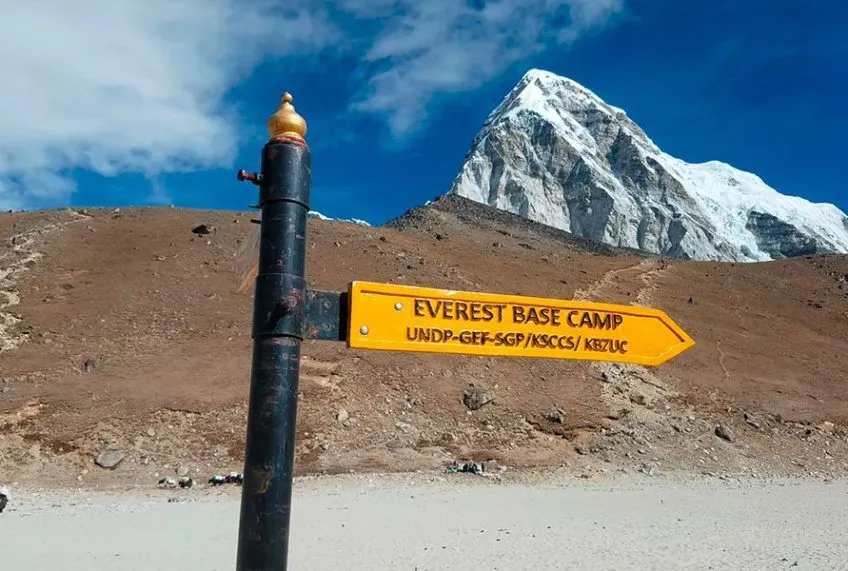Everest Base Camp Trek permits
The Everest Base Camp Trek is a remarkable adventure that requires obtaining specific permits to ensure compliance with local regulations and to support the region’s conservation efforts. Securing the necessary permits is a crucial part of the trek preparation, as it allows trekkers to access protected areas and helps maintain the infrastructure and environment of this world-renowned trekking route.
The primary permit required for the Everest Base Camp Trek is the Sagarmatha National Park Permit. This permit is essential for trekking within the boundaries of Sagarmatha National Park, a UNESCO World Heritage Site known for its stunning landscapes and diverse wildlife. The park’s permit helps fund conservation efforts and maintain the park’s natural beauty. This permit is typically obtained in Kathmandu or Lukla, where it is processed through the Nepal Tourism Board or the local authorities. The cost of the permit varies, and trekkers should ensure they have the necessary documents and fees ready when applying.
In addition to the Sagarmatha National Park Permit, trekkers must obtain the TIMS (Trekkers’ Information Management System) card. The TIMS card is designed to ensure trekkers’ safety and provide vital information to trekking agencies and authorities. It helps in monitoring the number of trekkers in the region, which assists in resource management and emergency response. TIMS cards are issued by the Trekking Agencies’ Association of Nepal (TAAN) and the Nepal Tourism Board. It is important to note that there are two types of TIMS cards: one for organized trekkers who book through a registered trekking agency, and one for independent trekkers. Each type has its own application process and associated fees.
To obtain these permits, trekkers need to provide specific documentation, including a valid passport, passport-sized photos, and details of their trek. It is advisable to work with a reputable trekking agency that can handle permit arrangements and ensure all paperwork is completed correctly. Agencies also offer guidance on permit fees and other requirements, making the process smoother for trekkers.
Understanding the permit requirements and obtaining them well in advance of your trek is essential for a hassle-free experience. It ensures compliance with local regulations, supports conservation efforts, and contributes to the overall safety and management of the trekking environment. By securing the necessary permits, trekkers not only gain access to the breathtaking landscapes of the Everest region but also play a role in preserving this extraordinary destination for future adventurers.
Introduction to Trek Permits
Trekking to Everest Base Camp, one of the most iconic adventures in the world, involves navigating a variety of administrative requirements, primarily permits. These permits are necessary not only for legal access to the trekking routes but also for supporting conservation efforts and managing tourism in the region. The process of obtaining permits ensures that trekkers adhere to local regulations and contribute to the preservation of the natural and cultural heritage of the Everest region. Trek permits are designed to help manage the number of visitors, protect the environment, and ensure the safety and well-being of trekkers. Understanding the different types of permits required, and the process to obtain them, is crucial for a successful and compliant trekking experience. By securing these permits, trekkers can enjoy their journey to Everest Base Camp while contributing to the sustainability of this remarkable destination.
Types of Permits Required
For the Everest Base Camp Trek, trekkers need to secure several permits to ensure they can legally access the trekking routes and support local conservation efforts. The primary permits include the Khumbu Pasang Lhamu Rural Municipality Permit, the Sagarmatha National Park Entry Permit, and the TIMS (Trekker’s Information Management System) Card. Each of these permits serves a specific purpose and is essential for different aspects of the trekking experience. The Khumbu Pasang Lhamu Rural Municipality Permit is required for trekking through local administrative areas, the Sagarmatha National Park Entry Permit grants access to the national park, and the TIMS Card helps manage and monitor trekking activities. Obtaining these permits involves a straightforward process, but it is crucial to ensure all paperwork is completed accurately and fees are paid to avoid any issues during the trek. Trekking agencies often assist in managing these permits, making the process more manageable for trekkers.
Khumbu Pasang Lhamu Rural Municipality Permit
The Khumbu Pasang Lhamu Rural Municipality Permit is an essential permit for trekkers traveling to Everest Base Camp. This permit is required for trekking through the Khumbu region, which encompasses the area around Everest and includes key stopovers such as Namche Bazaar and Lukla. The permit supports local infrastructure and development projects, contributing to the economic growth of the region and the well-being of its residents. It is issued by the Khumbu Pasang Lhamu Rural Municipality, which manages the area’s administrative and development needs. The permit can be obtained in Kathmandu or Lukla, often through a trekking agency that handles the application process. The cost of the permit varies and must be paid in local currency. This permit is crucial for accessing trekking routes in the Khumbu region and helps in managing the impact of tourism on local communities and the environment.
Sagarmatha National Park Entry Permit
The Sagarmatha National Park Entry Permit is a mandatory permit for trekkers heading to Everest Base Camp. This permit grants access to the Sagarmatha National Park, a UNESCO World Heritage Site renowned for its stunning landscapes and rich biodiversity. The permit is crucial for supporting conservation efforts within the park and ensuring the protection of its natural resources. It helps fund park maintenance, wildlife protection, and environmental preservation. The Sagarmatha National Park Entry Permit can be obtained through the Nepal Tourism Board or at the park’s entrance points in Lukla and Monjo. Trekking agencies often assist in arranging this permit, simplifying the process for trekkers. The permit fee varies depending on the nationality of the trekker and is typically paid in local currency. By obtaining this permit, trekkers contribute to the preservation of the park and ensure their legal right to trek within this protected area.
TIMS (Trekker’s Information Management System) Card
The TIMS (Trekker’s Information Management System) Card is a critical permit for trekkers on the Everest Base Camp route. The TIMS Card helps manage and monitor trekking activities by providing essential information about trekkers to local authorities. It is designed to enhance trekker safety, streamline emergency response, and support the overall management of trekking routes. There are two types of TIMS Cards: one for organized trekkers who book through registered trekking agencies and another for independent trekkers. The card is issued by the Trekking Agencies’ Association of Nepal (TAAN) and the Nepal Tourism Board. To obtain a TIMS Card, trekkers need to provide a valid passport, trek itinerary, and personal details. The application process involves paying a fee, which varies based on the type of card and the trekker’s nationality. The TIMS Card plays a vital role in ensuring that trekking activities are well-managed and that trekkers’ safety is prioritized.
How to Apply for Permits
Applying for permits for the Everest Base Camp Trek map involves several steps to ensure compliance with local regulations and proper documentation. The application process typically starts by gathering necessary documents, such as a valid passport, passport-sized photos, and details of the trekking itinerary. For the Sagarmatha National Park Entry Permit and the Khumbu Pasang Lhamu Rural Municipality Permit, trekkers can apply through the Nepal Tourism Board or local authorities in Kathmandu or Lukla. These permits are often obtained through trekking agencies, which handle the application process and ensure all requirements are met. The TIMS (Trekker’s Information Management System) Card requires an application through the Trekking Agencies’ Association of Nepal (TAAN) or the Nepal Tourism Board. The process involves filling out an application form and submitting personal details, trek itinerary, and a fee. It’s advisable to apply for these permits well in advance of the trek to avoid any last-minute complications and ensure all necessary permits are secured before embarking on the journey.
Permit Fees and Costs
The costs associated with permits for the Everest Base Camp Trek can vary based on the type of permit and the trekker’s nationality. The Sagarmatha National Park Entry Permit typically costs around $30 to $50 USD for foreigners, with varying fees for SAARC (South Asian Association for Regional Cooperation) countries. The Khumbu Pasang Lhamu Rural Municipality Permit usually costs around $20 to $30 USD. The TIMS (Trekker’s Information Management System) Card also has associated fees, typically around $10 to $20 USD for trekkers booking through a registered agency and slightly higher for independent trekkers. These fees contribute to the maintenance and management of trekking routes, support local infrastructure, and fund conservation efforts. It’s important to budget for these costs when planning your trek and ensure you have the necessary funds available for permit fees. Trekking agencies often provide detailed information on permit costs and can assist in managing payments.
Permit Validity and Duration
The validity and duration of trekking permits for the Everest Base Camp Trek Itinerary are important to understand for a smooth trekking experience. The Sagarmatha National Park Entry Permit is usually valid for the duration of the trek but typically for up to 30 days. If the trek extends beyond this period, an extension may be required. Similarly, the Khumbu Pasang Lhamu Rural Municipality Permit is valid for the duration of the trek, with the standard period also being up to 30 days. The TIMS (Trekker’s Information Management System) Card is generally valid for the duration of the trek but requires validity verification based on the trek itinerary. If there are changes to the planned trekking duration, trekkers should check the need for permit extensions or updates. Ensuring that permits are valid for the entire duration of the trek helps avoid any issues during the journey and ensures compliance with local regulations.
Where to Obtain Permits
Permits for the Everest Base Camp Trek can be obtained from several locations. The Sagarmatha National Park Entry Permit and the Khumbu Pasang Lhamu Rural Municipality Permit can be processed in Kathmandu at the Nepal Tourism Board or through local authorities in Lukla and Monjo. These permits are often arranged through trekking agencies, which can facilitate the application process and handle the required paperwork. The TIMS (Trekker’s Information Management System) Card can be obtained from the Trekking Agencies’ Association of Nepal (TAAN) office in Kathmandu or through the Nepal Tourism Board. Trekking agencies commonly assist in obtaining all necessary permits, making it easier for trekkers to secure them without visiting multiple offices. Ensuring that permits are obtained from the appropriate sources and within the required timeframe is essential for a smooth trekking experience.
Importance of Carrying Permits
Carrying the necessary permits during the Everest Base Camp Trek is crucial for several reasons. Firstly, it ensures compliance with local regulations and allows trekkers to legally access protected areas and trekking routes. Permits like the Sagarmatha National Park Entry Permit and the Khumbu Pasang Lhamu Rural Municipality Permit contribute to the preservation of natural and cultural resources by funding conservation efforts and supporting local infrastructure. The TIMS (Trekker’s Information Management System) Card plays a vital role in trekker safety by providing essential information to local authorities and helping in emergency situations. Having these permits readily available during the trek is essential, as checkpoints and park authorities may request to see them. Failure to produce the necessary permits can result in fines, delays, or even being turned back from the trek. Carrying valid permits ensures a smooth trekking experience and demonstrates respect for the region’s regulations and conservation efforts.
Regulations on Trekking Without Permits
Trekking without the required permits in the Everest Base Camp region can lead to serious consequences, including legal and financial penalties. Authorities strictly enforce permit regulations to manage the flow of trekkers, protect natural resources, and ensure safety. Without proper permits, trekkers risk being fined, deported, or denied access to trekking routes. This can disrupt plans, delay the trek, and incur additional costs for obtaining last-minute permits or dealing with legal issues. In addition to legal repercussions, trekking without permits undermines conservation efforts and the local economy, which relies on the fees generated from permits. The regulations are designed to ensure that trekking activities are conducted in a manner that respects both the environment and local communities. To avoid complications, trekkers should ensure they have all necessary permits before embarking on their journey. This includes securing permits through the proper channels and carrying them at all times during the trek.
Permit Renewal Process
The permit renewal process for the Everest Base Camp Trek is essential for trekkers who need to extend their stay beyond the initial permit validity period. Typically, the Sagarmatha National Park Entry Permit and the Khumbu Pasang Lhamu Rural Municipality Permit are valid for up to 30 days. If trekkers anticipate a longer trek, they should plan to renew their permits accordingly. Renewal can usually be handled through the Nepal Tourism Board or local authorities in the trekking region. For extending the Sagarmatha National Park permit, trekkers may need to visit the park’s office in Namche Bazaar or another authorized location. The process involves submitting an application, providing details of the extended trek, and paying any additional fees. For the Khumbu Pasang Lhamu permit, similar procedures apply. It’s important to apply for permit renewals well in advance of the expiration date to avoid any disruptions during the trek. Working with a trekking agency can simplify this process, as they often assist in managing permit extensions and ensuring compliance with local regulations.
Group vs. Individual Permit Requirements
Permit requirements for the Everest Base Camp Trek differ based on whether trekkers are traveling in a group or individually. For group trekkers, permits such as the TIMS (Trekker’s Information Management System) Card are generally managed by the trekking agency, which handles the application process and ensures that all members of the group have the necessary documentation. This collective approach simplifies the process and often includes the cost of permits in the overall trekking package. For individual trekkers, obtaining permits can be more complex, as they must apply for the TIMS Card and other necessary permits independently. Independent trekkers may face higher permit fees and need to navigate the application process themselves. The Sagarmatha National Park Entry Permit and the Khumbu Pasang Lhamu Rural Municipality Permit apply to both groups and individuals, but the process and associated fees remain the same. It’s crucial for both group and individual trekkers to ensure they have all required permits before starting the trek to avoid legal issues and ensure a smooth trekking experience.
Common Issues and Solutions
Common issues related to trekking permits for Everest Base Camp include delays in processing, incorrect or incomplete applications, and misunderstandings about permit requirements. Delays can occur if trekkers apply for permits too close to their departure date or if there are errors in the application. To address these issues, trekkers should apply for permits well in advance, double-check all documentation for accuracy, and work with reputable trekking agencies that can assist in the application process. Incomplete applications or missing documentation can also lead to problems; therefore, ensuring that all required paperwork is submitted and correctly filled out is essential. Misunderstandings about permit requirements, such as the need for specific permits or fees, can be clarified by consulting with trekking agencies or checking official guidelines from the Nepal Tourism Board. Keeping copies of all permits and receipts is also important for addressing any issues that may arise during the trek.
Conclusion and Preparation Tips
In conclusion, securing the necessary permits for the Everest Base Camp Trek is a critical aspect of preparation that ensures compliance with regulations, supports conservation efforts, and facilitates a smooth trekking experience. Proper planning involves understanding and obtaining the required permits, such as the Sagarmatha National Park Entry Permit, Khumbu Pasang Lhamu Rural Municipality Permit, and TIMS (Trekker’s Information Management System) Card. Trekkers should apply for permits well in advance, either through trekking agencies or directly with the relevant authorities, and be prepared for the renewal process if extending their trek. It’s important to be aware of the differences between group and individual permit requirements and address common issues such as application errors or delays. To ensure a hassle-free trek, trekkers should meticulously prepare all necessary documentation, carry valid permits throughout the journey, and consult with experienced trekking agencies for assistance. By following these preparation tips and understanding the importance of permits, trekkers can fully enjoy the adventure to Everest Base Camp while respecting local regulations and contributing to the region’s preservation.
Keep an eye for more news & updates on The Mail Blog!






